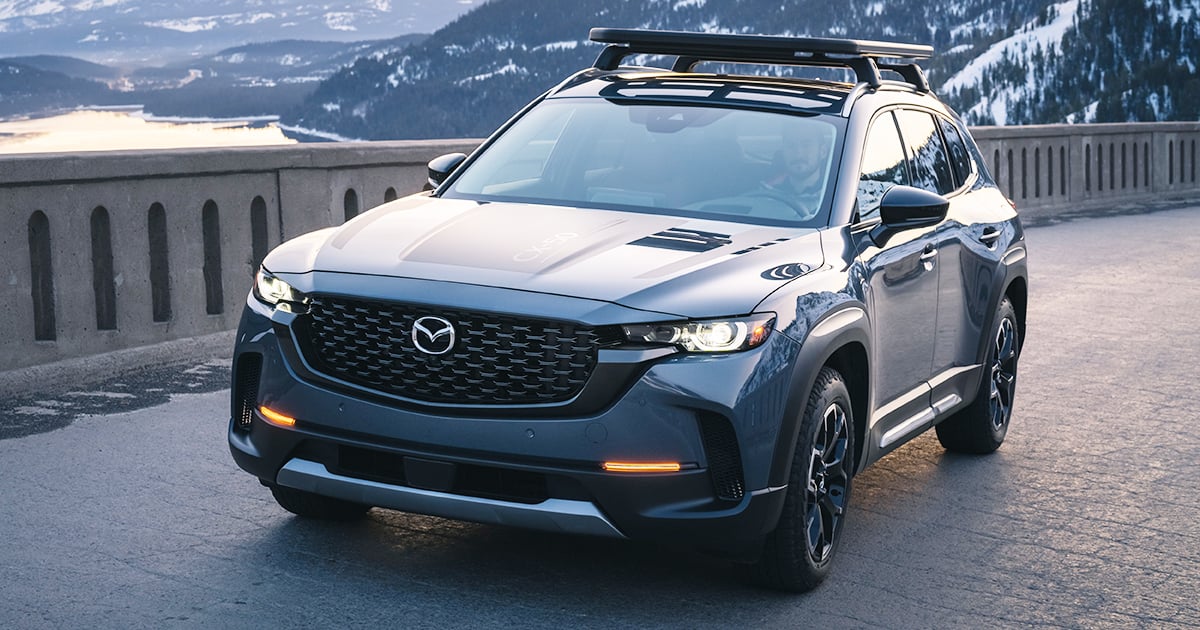
Nimble and engineering-minded Mazda is gaining traction as an upscale brand after years of aspiring to attract a more affluent customer.
The new three-row CX-90, which rides on Mazda’s rear-drive large crossover platform and offers flexible seating options in a spacious package, is resonating with buyers. Dealers report they have seen an influx of Mercedes-Benz, BMW and Acura owners cross-shopping the CX-90.
Mazda also has seen an uptick in market share this year. Through July, the small brand accounted for 2.4 percent of the market, compared with 2.1 percent the same time last year.
The availability of Mazda Financial Services also is yielding positive results. Backed by Toyota Financial Services and put into place in April 2020 during the first wave of the COVID-19 pandemic, it has provided Mazda with a dedicated finance arm, which has proved to be an especially powerful tool during the past year as economic volatility spilled over into the auto industry.
The CX-50 compact crossover that provides a more athletic alternative to the No. 1-selling CX-5 is expected to grow volume this year thanks to the addition of a second shift at Mazda’s factory in Huntsville, Ala., a joint venture with Toyota.
Mazda also pivoted its marketing approach by diversifying its portfolio of supporting advertising agencies, rather than relying heavily on the Mazda-dedicated group called Garage Team formed in 2010. Mazda CMO Brad Audet, who joined in 2020, said the automaker is working on a new brand platform.
Electric midsize crossover: An electric midsize crossover could turn up in late 2027, but it’s unlikely to replace the CX-90 in the lineup or the upcoming CX-70.
Electric compact crossover: Mazda could debut a CX-50-size electric crossover in late 2028.
MX-30: 2023 will be the last model year for the subcompact electric crossover that sold only in limited numbers in California with a battery range of just 100 miles.
CX-90: The all-new three-row crossover went on sale this year as a 2024 model. It is built on Mazda’s new rear-drive large crossover platform and offers a turbocharged 3.3-liter inline six-cylinder engine and a plug-in hybrid that uses a 100-kilowatt electric motor paired to a 2.5-liter four-cylinder engine. It is larger than the CX-9 in every way and offers six-, seven- and eight-passenger configurations. The top-end price starts just above $61,000 with shipping, and so far it’s successfully drawn more affluent customers to the brand. A freshen to the CX-90 is expected in 2026.
CX-9: The 2023 model year will be the last for the crossover.
CX-70: The all-new CX-70 five-seater is expected to arrive late in 2023 as a 2024 model. It will ride on Mazda’s new rear-drive large crossover platform and offer an inline six-cylinder engine, possibly with mild hybrid or optional plug-in hybrid with a four-cylinder engine.
CX-50: The all-wheel-drive compact crossover debuted last year as a new model for 2023. For 2024, it drops its base S and the Preferred Plus trims and otherwise carries over unchanged. The CX-50 is built at the Mazda Toyota Manufacturing USA plant in Huntsville, which just added a second shift to production. That will edge the plant closer to its annual capacity of 150,000. A hybrid powertrain could join the lineup sometime this year or in 2025, when a freshen is likely. A redesign in 2027 is expected.
CX-5: Mazda’s top-selling CX-5 carries over mostly unchanged for 2024, except for the addition of a Carbon Turbo trim and a 2-hp improvement on 2.5-liter S models. Mazda has been deliberating whether to continue selling the CX-5 alongside the CX-50, and the answer seems to be yes. While volume will likely taper, it’s expected that the CX-5 will get a redesign in 2025.
CX-30: For 2024, Mazda added a Carbon Turbo variant to the subcompact crossover’s lineup. The CX-30 will continue with small tweaks and additions to extend its life cycle.
Mazda3: Mazda’s compact car lineup, which comes as a sedan or hatchback, carries over mostly unchanged for 2024 except for the addition of a Carbon Turbo trim, an available 10.25-inch center touchscreen and slight safety tech enhancements. A redesign could come in late 2025, but it could carry on in current form and fade away through the end of the decade.
MX-5 Miata: Details have not been announced for 2024, but the Miata — for which longer design cycles have been typical — will likely carry over. A new generation could come in 2029.